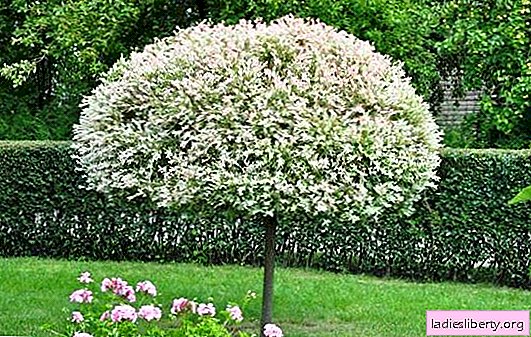
Willow is referred to as decorative landscape gardening trees. In nature, more than 600 species are known, some of them are grown in country houses. Breeders bred many varieties, including not only trees, but also shrubs, as well as creeping plants. Using a haircut, the plant can be given various forms, which allows you to use it when creating a bonsai. In traditional landscaping, willow is used as a hedge. The decorativeness of the tree is achieved due to the luxurious crown, which is different for each variety.
Growing willow: varieties and species (photo)
White willow
White willow is a tree whose height can reach 25 meters. On a powerful white trunk, all branches are located vertically upwards, with the exception of side shoots that rush down.
Grayish leaves appear along with earrings. Willow blossoms with small yellow flowers that bloom in April.
It is better to position the tree on the banks of rivers, ponds, near lakes. Willow prefers open sunny areas. Having planted a white willow, you can admire its beauty for quite some time. The life cycle of a tree is up to 100 years.
White weeping willow
A small compact tree, a variation of white willow. It features a bright yellow bark and light green leaves. The willow crown is quite unusual and gives the plant a bizarre appearance. Branches lush cascade descend to the ground, which adds decorativeness to the whole tree. Dwarf forms of weeping willow look good on a flower bed, next to flowers.

Babylon willow
Large plant with a weeping crown. The height of the tree reaches 15 meters. Flexible and thin shoots hang to the ground, and narrow leaves are cast with shine. Use a tree both in group plantings, and in single. Babylonian willow is characterized by its growth rate. Place for landing you need to choose wet.
Willow goat
A very beautiful tree with a decorative crown, the height of which reaches only 10 meters. The crown is round in shape, rather thick. The leaves are large, rounded, dark green in color. In March, goat willow blooms with small silver-yellow earrings that exude a honey aroma. This species is propagated by vaccination, less often by seeds.

Shaggy willow
Silver shrub with rounded leaves, the height of which does not exceed two meters. Shoots and leaves are covered with fluff. During flowering, releases flowers-candles, which are directed upwards. It tolerates harsh winters, prefers moist and nutritious soils. In landscape design, they are used to decorate artificial ponds.
Yves Haruko Nishiki
A small compact tree with drooping branches. Crohn is round, dense. Young leaves are covered with white spots, which gives the tree an extraordinary beauty. Old leaves lose this feature. Used to create compositions against shrubs with dark leaves.

Whole willow
Spreading shrubs up to 3 meters high. Willow prefers moist places. The plant can be recognized from afar by its leaves, which are located on the branches in an arcuate manner. This feature gives the shrub a resemblance to a fern. Flowering begins in May, dark red catkins bloom, exuding a hyacinth flavor.
Creeping willow "Armando"
A small rather ornamental shrub that can be shaped as a standard tree. Many gardeners grow in tubs, on balconies and terraces. Crohn bush creeping, the trunk is almost invisible. After flowering, it needs pruning, which provokes the growth of new shoots. The frost-resistant tree blooms with pink, silver fluffy inflorescences. With the advent of earrings, the plant is transformed.

How to plant willow
A place for planting a tree needs to be selected moist with well-fertilized soil. Willow grows well in light sandy soils. When planting, humus or mature compost is added to the ground.
For planting, choose an annual seedling with a well-developed root system. The best time for planting a plant is early spring. As soon as the snow has fallen, willow should be planted. For undersized forms and shrubs, the size of the pit is 50 * 50 * 50. For tall trees, the landing pit should be a little larger. After planting, the seedling should be well watered and mulched the soil.
Willow care: watering, haircut, top dressing
It is not difficult to grow willow; caring for it will not be a hassle. The main care procedures are reduced to watering, crown formation and top dressing.
How to water willow
In the wild, willow grows on the banks of rivers and ponds, so it needs frequent watering. This plant tolerates spring flooding and places with a high occurrence of groundwater.
In dry periods, the tree needs to be regularly watered, spraying the crown of young seedlings. For one adult plant, several buckets of water are consumed.
Top dressing
Like all trees, willow needs top dressing, which allows you to maintain its decorative effect. In spring, the soil around the tree is loosened, covering up mineral fertilizers.
Willow responds well to regular feeding with organic and mineral fertilizers. You need to make them throughout the season, depending on the plant variety.
Crown formation
Willow tolerates haircut and crown formation. Skilful gardeners with the help of pruning create trees with an unusually beautiful crown.
The first haircut should be carried out several years after planting a seedling. At first, the shoots are given the opportunity to grow freely. Pruning is done when the tree branches reach a height of about 1 meter.
Typically, crown formation begins when the plant has already flowered. Young shoots are shortened somewhere by 20 cm, making a cut over the kidney, which looks out. Tree pruning should be carried out regularly, which allows you to grow beautiful specimens with a dense crown.
Willow planting: reproduction (photo)
Under natural conditions, willows breed by seeds, which retain their germination for several days. Ripening seeds are carried by the wind and birds. But the reproduction of varietal willows by seeds is rather difficult. As a rule, you can get a seedling only by resorting to cuttings. Some varieties reproduce exclusively by vaccination. For planting such species, it is better to purchase ready-made seedlings in the nursery.
Cuttings need to be harvested in autumn or early spring, when the sap flow is slowed down. Cuttings are cut from shoots whose age exceeds two years, which increases the chances of rooting. Only the middle of the branch, about 20 cm long, is taken on the stalk.

Prepared cuttings are planted in a greenhouse or a separate container. To do this, prepare a trench, deepening the planting material by several buds in the ground. The distance between the seedlings should be about 30 cm.
Care for willow seedlings in the greenhouse should be carried out constantly. It is necessary to maintain the level of humidity, as well as loosen the soil and remove the overgrowth of other trees, which can clog young plantings.
Cuttings quickly take root and start to grow, but there is no need to rush when planting in the garden. Young seedlings should winter in the greenhouse. They are planted in a permanent place only in the second year. Trees obtained in this way quickly grow and form.











